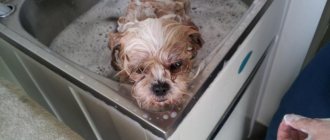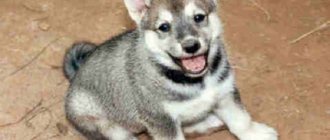Photo by Mitchell Orr on Unsplash
Vertical ears are a hallmark of a number of purebred dogs. Despite the naturalness of the situation, in some cases the owner has to rack his brains about how to help his pet.
Let's look at the main causes of drooping ears in puppies and explain how they can be diagnosed depending on the specific case.
Why is it important for your ears to go up?
Not all dog lovers choose to take a dog with them simply to complete their family. For some people they are a source of income, it is necessary that the "examples" respect certain characteristics and measures in order to meet the standard of the breed being bred.
If only one of the numbers is out of line, many puppies will be put up for adoption. But is it really important for their ears to go up?
To answer this question, you need to know the importance of their movement: a dog uses its body to communicate, and not being able to use its ears will be a hindrance for it in communicating with other dogs and people.
But there are dog breeds that require them to be dropped instead: hunting dogs or truffle dogs, in order to better smell and focus on exploration, have their ears dropped by nature.
This allows them to avoid being distracted by cues from the environment (and the forest will be full of noises that can distract them) and focus on their sense of smell.
On the other hand, speech differs for a "show" dog or for those selected to maintain breed standards: even the angle of ear opening is calculated if it is turned too far to the right or left and, or less pointed.
But for many of us, who often choose the path of adoption, it is enough that our little friend is healthy, and everything else is indifferent, nature will take its course and sooner or later alert us.
Why do you need to put on dog ears?
Straightened and even ears are the main indicator that the dog belongs to an elite breed. Dogs with long ears that stick out upward look proud, courageous, and impressive. This is one of the main reasons why dogs' hearing organs need to be erect.
But still, many owners often do not pay much attention to the appearance of their pets’ ears, much less their position. They perceive the puppy as he is. Some breed standards require a straight and hanging position.
If a dog does not have ears, then this may be a physiological feature of the breed. In this case, the owner can correct them. The main thing is to study the features of this process. In any case, the choice should remain with the person; the dog does not care what kind of ears it has, this does not in any way affect its devotion and love.
But when does a puppy raise its ears?
Just like us humans, every puppy has its own growing season and should never be forced. The puppy's ear cartilage has not yet reached maturity: the ear is soft and quite large compared to the head.
Only with the formation of elastin networks and bundles of collagen fibers in the cartilage tissue will the ear rise. Some people, especially breeders, are frightened by the thought that the cartilage in the ear may break rather than weld together, causing the dog to grow up with one ear up and the other down.
Therefore, they decide to keep the puppies isolated both from other animals and from people: this is wrong, because in order to have a dog in the family that will not be aggressive and unsociable, you need to teach it to communicate from an early age.
The time it takes for the ears to rise depends on various factors:
- dog breed : in dogs whose ears are already the same size, puppies of 2 months raise them, like a Siberian Husky, in a German Shepherd, for example, a puppy can even be 6-7 months old;
- Period of development of the dog : often in puppies the resting position of the ears, lowered, remains for the entire period of teething, even if the often lazy nature of the dog can lengthen this time;
- Parasitic diseases due to the presence of worms in the ear canal (helminthic infections): in this case, one should be surprised by the opposite, that is, if the ears remain in an upright position even after 2 months, because this is a sign of infection;
- Ear diseases in dogs and tumors;
- Birth injury;
- Stressful conditions in dogs;
- Proper nutrition with sufficient intake of vitamins;
- Side effects from medications or vaccinations.
© shutterstock
Why should they be installed?
Placed ears as an indicator of the breed are a necessary attribute for a puppy planning a show career. To obtain a place of honor, erect ears are considered a necessity for:
- Spitz-shaped;
- Australian Bouvier;
- terriers;
- Dobermans;
- pinschers;
- German and Belgian shepherds;
- boxers and a number of other dog breeds.
In addition to the aesthetic point of view, it is important to note the medical one. If the ears are erect, then the likelihood of hearing diseases is reduced. Pathogenic microflora develops more often in lop-eared representatives deprived of natural ventilation.
What to do if your dog doesn't have ears?
Knowing why the rise does not occur, you can try to help your pet at home:
- Review your diet. Calcified nutrition helps strengthen the puppy’s cartilage tissue. Focus on natural cottage cheese and goat milk. Gelatin is no less beneficial for cartilage, so treat your pet with jellied pork ears.
- Buy vitamins (such as Volmar, Kanvit, Calcefit, Silver Trail, Polydex, Beafarm, Canina, Side Plus). Don't make any choices without your veterinarian's approval. Properly selected vitamins will eliminate the deficiency of substances and strengthen the pet’s bone and cartilage tissues.
- Make sure there is sufficient blood supply. You can install the ears using a special massage that accelerates blood flow and is performed on a daily basis:
- Grasp the base of the ear using 2 fingers.
- Start massaging the ear tissue, moving from the base to the tip.
- Use smooth movements and gently pull the ear upward.
Don't forget about the comprehensive methodology. If you choose only one of the proposed methods, the desired effect cannot be achieved.
Please note that the proposed methods only work at the initial stage of development. If the dog does not show results, then do not rush to undergo surgery. In the absence of serious injuries or birth defects, gluing will cope with the task.
Possible solutions
While our little puppy is completely healthy, we can only wait until he grows up and his ears rise up. However, after about 8 months, if the ears just aren't showing signs of wanting to stand up, you need to take him to an excellent veterinarian: there may be a troubling cause at the base.
However, the vet always tells us what to do:
- Make sure that your puppy’s diet is not lacking in vitamins and calcium: it is useful both for teething and for the maturation of cartilage;
- do not exceed the desire to protect him from any ear injury: this will affect his psychological state;
- maintain a calm environment free from anxiety and stress;
- carry out periodic checks with a veterinarian;
- bandage the ears, fixing them in an upright position or wrapping them up;
- use adhesive tape to keep the ear straight;
- select operation.
The main thing is always and only the health of the puppy. In any case, the right choice is to rely on the veterinarian and follow his instructions, and if invasive treatments are necessary, we must trust the doctor equally.
However, the puppy must live to its age.
Playing with other animals, interacting with small and large people, and exploring the world until you get tired will become his foundation on which he will grow into a balanced and confident adult dog.
Source
At what age do Yorkies' ears stand up?
By adopting a small puppy, we take on great responsibility - it is important not only that he grows healthy and beautiful, but also develops correctly.
To do this, you should pay attention to developmental features, for example, to ensure that the puppy’s ears stand up on time and correctly.
To do this, you need to know when Yorkies' ears stand up, why this may not happen, and how to place them if necessary.
Why don't they get up
Regardless of the baby's gender, by the age of four months their ears should already be raised. Sometimes this happens after changing teeth.
But if four months have already passed, the teeth have changed, and the ears are still not standing, it is necessary to first determine the cause of this problem. It may lie in the following:
- Too big. It happens that cartilage in dogs develops ahead of schedule, so they become disproportionately large and cannot rise due to their weight.
- Too much wool. A lot of hair on the tips of the ears makes them too heavy and therefore they do not stand up.
- Lack of calcium and vitamins. Most often, in all three cases, a Yorkie's ears can be raised using several traditional methods.
But owners should know that if the pet’s ears are too large, they may not rise up—unfortunately, even the seller cannot predict such an outcome.
In such cases, you need to remember that a dog is, first of all, a friend and family member, and not an exhibition exhibit. This means that the animal must be loved, despite its small shortcomings.
How to put
To begin with, we note that if a dog’s ears rise and then fall, then there is no need to worry - they often droop during the change of teeth. If they got up once, then nature will take its toll the second time.
And in cases where the ears do not stand up at the age of three or four months, they often just need help.
First of all, you need to establish the cause of what happened to your ears. If the problem lies in the abundance of hair at their ends, then the solution to the problem is quite simple - just trim off the excess.
It is not recommended to do this yourself, as the dog can be injured due to inexperience, and unevenly cut hair can seriously spoil its appearance.
For your first haircut, you should contact a professional or use a special trimmer.
If the problem is that the cartilage is too thin (this can be determined by palpating it), it is better to contact a veterinarian who will prescribe the appropriate vitamins.
You should not choose a remedy yourself, because excess calcium will not bring health to the dog; in addition, it must not only be consumed as food, but also absorbed by the body.
As measures that can be applied independently, Yorkie owners indicate a change in diet - it is recommended to add boiled beef tails and ears, as well as broth cooked on their basis. This will also help your ears become stronger.
"Crown" for erect ears
The last recommendation is to create a “crown”, that is, secure the ears in an upright position with an adhesive plaster.
After just a few days of wearing it, you can notice that the ears are standing up - the main thing after that is to make sure that they don’t fall off again.
To secure it in a vertical position, you will need a not very hard fabric-based patch. The width should be about 1.5 centimeters; the length is enough for one procedure - 6-8 centimeters.
It is better to cut the ears short or trim them with a trimmer before attaching them.
Each ear needs to be “flattened” with the left and right sides towards each other, and secured in this state with a plaster, wrapping it several times in the middle of the ear at some distance from the base.
When this task is completed, you need to fasten them together - as a result, the Yorkie will have a kind of “crown” on his head, which will keep his ears in a vertical position.
You can walk with this “decoration” from five days to a month, taking daily breaks once or twice a week.
At the same time, observe whether the ears are standing without the patch - if they begin to “fall asleep” again, then the procedure must be continued.
Photo gallery
These cute dogs are quite unpretentious and modest. They easily adapt to any circumstances, let's look at a small photo selection of these beautiful creatures.
Video
If you need to install your pet's ears, but you don't know how, but everything seems so easy and simple. But you have never seen or done this. Then this video clip is especially for you.
vsepesiki.ru
How many months does a Spitz grow?
Let's look at the main stages of a dog's growth and find out at what age a Spitz stops growing.
One of the parameters by which you can determine whether a dog is healthy is height. Therefore, it is important to know at what stage of life what height a pet should be, and to what age Spitz grow.
Little dog
The Spitz is fully formed at two to three years old, the development of bones and organs ends, and the puppy turns into an adult dog.
Development by months
In the process of growing up, the following main stages are distinguished, by which one can determine whether the dog’s health and development are normal.
First month
At birth, Pomeranians appear tiny. Their weight ranges from 50 to 130 grams. In relation to the bitch, this is only 5 percent. Other German Spitz are slightly larger. Naturally, male Pomeranians are larger than female Pomeranians.
In the photo you will see how Spitz are born:
Newborn puppy
The skin is still visible through the faint fuzz. The puppies' heads are quite large compared to their bodies, which are very short with a plump belly. At first, the body parts are disproportionate, and the baby himself is helpless.
Reference . The color of the baby's skin indicates the future color of the Spitz's coat.
It is important to monitor the color of the puppies' skin, and if a blue tint appears, contact your veterinarian immediately. This color may be a sign of serious illness.
Two weeks after birth:
- babies begin to get up;
- eyes - see (puppies begin to recognize others);
- The ears begin to hear only by the 18th day.
After three weeks, the puppies begin to go to the toilet on their own; maternal assistance in emptying is no longer needed. Babies will begin to move actively only towards the end of the first month.
Second and third month
When babies are already two months old, baby teeth begin to emerge. Puppies begin to be capricious and constantly chew on something. It is at this stage of growing up that you buy special toys for your kids and put things away to keep them safe. At this age, the character changes, and the puppy prepares to part with its mother. He can already be walked, but only after having received vaccinations.
At three months the first molt begins, the puppy's fur changes to an adult fur coat. At this time, you can accurately determine what color the pet will grow up to be. The ears are actively growing, and the muzzle becomes elongated.
Dog at 2 months
Fourth and fifth month
In the fourth month of life, Spitz dogs become almost completely bald due to shedding, and therefore have a very unsightly appearance. This is because the thick undercoat sheds more slowly than the main coat, which is what makes these dogs so cute. First of all, the paws and muzzle go bald, and then the rest of the body.
If the puppy has gone completely bald, simultaneously losing its undercoat and fur, consult a veterinarian. He will review the diet and prescribe a vitamin complex.
At this age, teeth are actively changing. He quickly gains weight and height at the withers. The Spitz acquires standard proportions.
Sixth to ninth month
During this period, babies continue to actively grow and shed. By eight months, the teeth are completely replaced by molars.
Check your mouth regularly to avoid bite defects. Spitz dogs have powerful teeth with deep roots, which can affect their timely replacement.
If you see that the molar has grown, but the baby tooth has not yet fallen out, take your pet to a canine dentist. Untimely removal of primary molars leads to improper bite formation and tooth decay that did not fall out on time.
At 9 months, Spitz dogs reach show age. The coat is fully formed and a presentable appearance appears.
At 9 months
1 year
For females, this period means the first heat, but it is still too early to breed them. The boys begin to actively mark their territory.
By definition, at this time the last strong moult ends, the fur becomes adult. The next moults will not be as abundant.
At one year old, pets stop growing and begin to actively gain muscle mass.
In one year
2-3 years
Spitz dogs finally grow up by two years of age. Bitches begin their menstrual cycle and are ready to give birth. At two years the body is fully formed, in accordance with recognized breed standards.
Which dogs need ears and why?
Before moving on to ways to correct lop ears, you need to understand why this is necessary. Artificial staging is resorted to for two purposes:
- Aesthetic. Standing ears are fixed in the exterior of many breeds, so their absence can cause disqualification or a low rating at the exhibition.
- Medical. The vertical position of the ears reduces the likelihood of developing hearing diseases. Thanks to good ventilation, pathogenic microflora develop inside much less often.
The hanging form makes the pet look cute and harmless, which negatively affects the appearance of fighting dogs. For this reason, some of them have to do docking for a more impressive image.
Breeds with erect ears
All puppies are born with fold ears, but some of them change their appearance dramatically as they grow up. These breeds include the following:
- German and Belgian shepherds;
- Spitz;
- huskies and huskies;
- Australian Bouviers;
- Yorkies;
- Russian toi;
- Scotch Terriers.
These animals require the help of their owners only in emergency situations when self-staging is behind schedule.
Breeds with cropped ears
Despite active condemnation by animal rights activists, docking is prescribed in the standard for many service breeds. These include:
- American Staffordshire Terriers;
- Caucasian Shepherd Dogs;
- pit bulls;
- Dobermans;
- miniature pinschers;
- Alabaev;
- Cane Corso;
- boxers;
- Great Dane
The ears of these animals do not stand up on their own, so they are given a pointed triangular shape through surgery. It is carried out no later than 4-6 months due to the gradual worsening of pain and the high likelihood of scarring. The easiest time for puppies to undergo docking is in the first 2 weeks after birth.
Deviations or norm
Each dog has individual characteristics, so do not panic if your pet develops a little faster or slower than prescribed by the standards.
Several factors influence the growth and development of a Spitz:
- Genetics. If your pet's body weight deviates from the standards, pay attention to the pedigree. Perhaps your pet's mom or dad had greater height and weight than indicated in the breed standards.
- Diet. If your baby eats only natural food, he will gain weight by six months. On dry food, even premium-class Spitz dogs gain weight more slowly.
- Vitamins. The lack of vitamins in a dog’s body, like diet, affects the development of its skeleton.
- Activity. Long walks with physical activity contribute to the formation of a large muscle corset. A puppy that runs a lot will be larger and more athletic than one that leads a moderate lifestyle.
Ear placement methods
In order to put on the puppy's ears, experts recommend using the gluing method.
Tube-shaped adhesive
For this method, you will need a roll of adhesive plaster (preferably silk-based), as well as scissors and a clipper or trimmer.
Before starting the procedure, you need to wash the puppy and dry its fur, and then secure the dog properly: for example, wrap it in a towel or have the help of an assistant.
Then you need to remove as much hair as possible from the entire surface of the ear: otherwise the patch will not stick. Then each ear of the Yorkie is folded into a tube, but so that the ear canal remains open.
An adhesive plaster is wrapped around each of the ears rolled into a tube, and you need to glue it carefully: without pulling it too tightly and so that no folds form.
At the end of the entire procedure, the ears are fixed vertically: they are glued together using the same adhesive plaster in a raised state.
In this case, you need to leave a small distance between them so that the ears stand strictly vertical.
The puppy should walk with its ears rolled into tubes and fixed for no longer than three days, after which the structure must be removed, first moistening the adhesive plaster with vegetable oil.
If this method does not help to raise the ears, after some time the procedure must be repeated, perhaps more than once.
Ear gluing using the folding method
There is another way to set the ears. To do this, the same preliminary procedures are performed as with the previous method: that is, the Yorkie needs to be washed, dried, fixed and his ears cut or shaved.
After this, each of the ears is folded in half lengthwise, but so that no creases or folds form . Both ears folded in half are connected at the top of the head and wrapped with adhesive tape.
This design is also worn for three days, then it needs to be removed, and after the ears have rested for several days, repeat it if they still do not rise.
This procedure may need to be repeated several times to achieve the desired result..
Nuances in the development of different subspecies
The maturation of different types of Spitz proceeds approximately the same. Regardless of the breed, the development from a baby to an adult dog takes three years. They reach their final size by about six months.
There are some features:
- One litter may produce pets of different weight, height and color.
- A miniature size that does not meet standards may indicate the presence of diseases. Harnesses and collars are not suitable for these puppies. They should not jump from heights to avoid damaging their joints.
- If your pet is larger than the accepted standards, accept it. Most often, the reason is the presence of large individuals in the pedigree. It is impossible to influence the size of a pet without harming its health.
Why don't my puppy's ears go up?
The following factors can slow down or stop the process:
- the pet is not purebred;
- large puppy size;
- weakened immune system;
- period of teeth change;
- stress;
- mineral deficiency.
Even if you bought a puppy with erect ears, they may fall off when moving home. The reason is fear. In an unfamiliar environment, the baby behaves warily. Usually the situation returns to normal after a few weeks.
Owner reviews
Spitz is our first and favorite dog. We were very worried about how to make sure that the baby developed correctly. But, as it turned out, if you stick to the regime and ensure compliance with the standard, he will grow up healthy and beautiful.
We are already two years old. The girl is fully formed. We are planning to take him to the next heat. All that remains is to find the right boy.
This is our second Spitz. The first boy was fed natural food, but there was not enough time for the second. As a result, boys are different sizes. The one who ate natural foods grew larger.
Source
When a German Shepherd's ears stand up with photos and videos
In this article we will tell you about when a German Shepherd’s ears stand up and what to do if this does not happen in time. If you adopted a puppy from an experienced breeder, then you are already familiar with the basic rules of care, education and feeding. Do you know what the standard and conformation of this breed should be? But some issues need to be given special attention and approached with full responsibility.
According to standard
A purebred German Shepherd should have upright, medium-sized ears with pointed tips. The auricle is placed forward. When your dog has them hanging on the sides or broken, it means that the path to all kinds of exhibitions and competitions is, unfortunately, closed.
But while your puppy is still small, do not rush to worry. Even if your baby already has one ear erect and the other one is still hanging. After all, each shepherd is individual and the exact day when its ears will stand up cannot be predicted. The best thing to do is sit back and watch your puppy grow into a teenager very quickly.
The time has come
In how many months should this great event take place? Based on the knowledge of experienced dog breeders, the period of ear formation begins at one and a half months and ends at five.
Thanks to the strengthening of the cartilage, the ear gradually increases in size, becoming larger and heavier. Since the stage of teeth change is directly related to the phase of ear formation, they can stand up at two months and, without having time to fully strengthen, fall again by three months. This is how the body of a German Shepherd works and there is nothing wrong with it.
In the period between five and six months you need to be extremely careful and constantly monitor your ears. If they have not stood up again by six months, then you should contact a veterinarian as soon as possible. Replacement of ears after seven months is an extremely difficult and sometimes impossible task.
There are several reasons why a puppy's ears do not stand up:
- fright;
- non-purebred ancestry;
- poor maternal nutrition during pregnancy;
- lack of calcium, phosphorus in the body.
Necessary prevention
If the ears do not stand up on their own after five to six months, then it is necessary to perform some procedures to prevent a possible defect.
What to do? It's not that complicated. During the period of active growth, the puppy’s body especially lacks vitamins and microelements. You should add bone meal, kefir, and fish to your diet. At the same time as the correct feeding regimen, strengthen the muscles of the cartilage tissue with massage, thereby providing the puppy’s ear with the necessary blood circulation. Natural development can also be helped by various sounds that you suddenly make. Thanks to this, the ears are tensed every time and are fixed vertically.
If there is no proper care and attention for the ears, then no matter how hard you try, there will be no good result. In addition to regular cleaning, you should monitor the health of each ear. If there is any redness or discharge, contact your veterinarian immediately.
Nothing helped? This means it's time for radical measures.
Before you start reeling
To get your ears fitted, it is best to contact an experienced specialist. But if you are confident in yourself and your abilities, you can do this procedure yourself. Below we provide some important tips to help you.
Firstly, do not rush this process; it is better to wait six months, when the change of teeth ends. If you rush, you will only harm the German Shepherd and in the worst case, the ears may not stand up.
Secondly, do not overuse calcium. Fifty grams of yogurt or kefir is much better than nutritional supplements. The excess will be deposited in the dog's bones and lead to orthopedic problems in the future.
Thirdly, monitor the implementation of the schedule of vaccinations and deworming. The health of the puppy is directly related to the muscle strength of the ears.
Fifthly, do not forget about special toys and bones. By gnawing on them, the pet strengthens the muscles of the ears.
Sixth, do not allow other dogs to drag your pet by the ears to avoid injury.
We begin to reel in
Before you start the process, remember that you cannot use adhesive materials: tape, tape. They will only cause pain to the German Shepherd.
First of all, you will need foam rollers of the correct size. Then we purchase a surgical plaster. You will also need two pencils and medical glue. To connect the taped ears you need to find a suitable stick, for example, an ice cream stick.
To begin, remove the plastic axle from the center of the curler, and instead insert a pencil to a depth of two centimeters. Apply glue to the surface of the curler circumference so that it does not drip. Otherwise, it will get into the ear and cause irritation.
They must be placed in the lower part of the auricle so that the ear canal remains open. To make the ear stick, you should lightly press it against the curlers.
Tape the bandage tightly around your ear to the curlers, holding the pencil. Don't forget to remove it before finishing the process. In order not to interfere with blood circulation in the ear, the patch should not be wrapped too tightly.
Using an ice cream stick, fix the erect position of the ears - attach it to the back with glue.
What to do after winding
German Shepherd puppies are very active and it is difficult to guess how long it will take the baby to pull off the strapped structure if given the opportunity. Therefore, you need to distract your baby with play to allow the glue to set.
It is necessary to keep the homemade device for about two weeks. This time is enough to insert your pet's ears. Carefully monitor the condition of the winding and correct any shortcomings in a timely manner.
After the specified period has expired, carefully remove the patch using a special adhesive solvent. Do not perform actions abruptly - you will cause pain to the puppy.
Latest recommendations
If nothing helps you, then, if you wish, you can go to extreme measures and have your German Shepherd undergo ear implantation surgery. You won’t solve the problem, but you can make the dog fit the standard.
To prevent radical procedures, care for the puppy properly and monitor its diet. The dog's health depends entirely on you. Everything else is a genetic disposition.
Did you like the article? Tell us how your dog’s ears developed?
Tags: Shepherds, Workers
provsehsobak.ru
At what months do Spitz puppies' ears stand up?
2 bowls, preferably with a stand,
toilet (although you can lay diapers directly on the floor),
disposable or reusable diapers,
toys without small parts,
massage brush (you can use the one for people),
shampoo and conditioner (for example, from the middle price category Biogroom)
vitamins for puppies. For example I prefer:
1. Polidex Polivit calcium Plus - Polidex Polivit Ca + (for strengthening bone tissue and for general strengthening of the body, a course of 21 days every three months, especially during the period of changing teeth),
2. Artroglycan (to strengthen ligaments, a course of 21 days every six months, since Spitz knees are one of the weak points),
3. Brevers 8 in1 (brewer's yeast for wool, course 21 days every six months, especially during the molting period). Although I use "Brewer's Yeast with Sulfur" which is for humans.
4. Fish oil in capsules (in pharmacies for people) as a general tonic
FEEDING:
If it is not possible to feed by the hour, then we leave the food until the evening, and the puppy will eat when it is convenient for him.
Feed either food or natural food. Do not mix them in one feeding!
food for up to 4 months!
If natural food:
Meat: beef, veal. Chicken is undesirable (your eyes may water). No pork (digestion is impaired). The most useful meat product is beef or lamb unpeeled tripe - a storehouse of enzymes and microelements.
Porridge: buckwheat, rice, rolled oats.
Vegetables: carrots, also pumpkin, broccoli. I recommend letting you try a small piece of all the vegetables and fruits that you eat yourself. This way you will understand what the dog likes and what it doesn’t.
If it is impossible to feed often, it is allowed to leave food until the evening.
Chews – soft bones (hard ones will spoil the bite), carrots (they love them very much. Give them infrequently. Not digestible, but cleans teeth well)
It is strictly forbidden to eat: sweets (except in cases of hypoglycemia - lack of glucose in the blood, when the dog gets chills), fatty foods (there will be indigestion), smoked and fried foods (fraught with allergies).
VACCINATIONS:
I use two multivaccine vaccination schemes:
Option one: Nobivac Puppi / Nobivac Pappi at 4 weeks, then Nobivac DHPPI + Lepto / Nobivac multivaccine at 8 and 12 weeks
Option two: Vanguard multivaccine at 6, 9 and 12 weeks. I love Vanguard, because today in our region it is the only vaccine that also vaccinates against Coronavirus (mutated enteritis).
At 12-15 months (at the earliest - 1 year, at the latest - 12 months after the last vaccination) and then once a year - a multivaccine. Rabies vaccination - also once a year.
If the dog’s immunity is strong, then the multivaccine and rabies can be vaccinated together, but I don’t like this and leave a gap of at least three weeks between vaccinations.
Attention: 7-10 days before any vaccination, worm with, for example, Drontal or Endogard!
The dose of vaccination is the same for a Spitz, a shepherd, a puppy, or an adult dog, so the animal should not be sick during the change of teeth, during estrus.
HOME GROOMING OF A SPIECE:
You need to brush your Spitz daily, at least once a week. First along the growth of the coat, then against the growth of the coat. Sprinkle baby powder behind the ears once a week or two if there is a tendency to tangles.
Bathroom: it is better to wash your Spitz at least once a month. Afterwards, dry it with a hairdryer, combing the fur against the grain from head to tip of tail.
Haircut is divided into everyday and exhibition. It is better to do the show one at the groomer. Everyday - by ourselves. Trim your ears in a semicircle. Trim the excess hair around the claws, the base of the tail and the “pants” - diagonally.
Manicure (lapakure) – at least once a week, maximum once a month. Cuts his hair with claw clippers.
Cleaning the eyes – Small breed dogs often have watery eyes. This means that either the food is not suitable for the dog (food allergy), or she has narrow tear ducts. The easiest option is to wipe the area around the eyes with any lens liquid (buy at a pharmacy for people) or wipe the eyes with Oftal / Beaphar.
Ear cleaning – from once a week to once a month. Wax in a dog's ear is a sign of an allergy.
Treatment for fur - used during the shedding period, for example, with mink oil from Befar.
Vitamins for wool - during the molting period are required, the rest of the time - optional. The best are, but you can use brewer's yeast with sulfur (in pet pharmacies or pharmacies for people) and Biotin (in many countries it is considered a super product for hair, skin, nails, but in our country it is not popular - they are sold in any pharmacies as part of multivitamins or separately.
How to put on a puppy's ears using glue
Before carrying out the procedure, you need to make sure that it is necessary:
- Make sure there are creases. If there is a horizontal area with thin cartilage tissue, the ears cannot take a natural position on their own.
- Check the canvas for weak spots and scars. If a crease is not detected, then the reason lies in a weakened or scarred area. To determine such a location:
- Squeeze the base of the auricle with 2 fingers and gently feel the entire surface, moving upward.
- Having found a small stain or a thin strip of fabric, pinch it on both sides. If, when pressed, the ear assumes a vertical position, then the cause has been found.
- Determine the location of the weak point. If the upper part of the cartilage is affected, the problem can be solved by taking vitamins, and if both the base and middle of the ear are affected, you cannot do without gluing.
Soft fabrics, eliminating creases, scars and weak spots, are restored by changing the diet and subsequent gluing if necessary.
For safety, the first gluing is best done under the guidance of an experienced breeder. He will tell you how to safely install the structure and explain which option is preferable in the presence or absence of docking.
Undocked
For undocked small breed dogs, a soft design is suitable, fixed with cotton swabs and a 3-centimeter adhesive plaster:
- Use a trimmer to shave the hair on each side of the ear. The absence of fur will reduce the weight of the ear and make subsequent removal of the patch painless. Trim the remaining areas of fur using scissors.
- Degrease the skin with alcohol to securely fix the patch.
- Measure a piece of adhesive equal to the height of the sink and place it on a flat surface, non-adhesive side up.
- Cut the cotton swab in half. The resulting fixative must be placed on top of the patch. Add 2 more layers of adhesive tape on top of the stick.
- Make a blank from the resulting sizing that matches the shape of the auricle.
- Glue the blank to the inside of the ear without obstructing the visibility of the ear canal.
- Place duct tape along the base of each ear, creating a tube shape. Make sure there is at least 1cm between the edges. This will ensure ventilation and easy inspection.
Please note that after 6 days the structure must be removed. The break is approximately half a day, after which the puppy is given a new gluing. The tape is worn until the desired position is achieved.
Docked
Rigid designs are recommended for both large breeds and those with long, cropped ears. The gluing is carried out only after the surgical sutures have been tightened.
The ear frame is installed using a similar algorithm to the soft design, but using slightly different materials and tools:
- Instead of cotton swabs, foam rollers are used, glued with medical glue.
- The outside of the ear is secured with ice cream sticks.
- At the stage of fixing the final structure, the adhesive plaster is replaced with strong adhesive tape (you can use both painter’s and construction tape).
Is ear taping safe?
If all rules are followed, gluing is not only effective, but also safe.
If mistakes are made, the following problems may occur:
- Production that does not meet the standard. A flaw in fixation will result in an irregular shape.
- Circulatory disorders . Observed with strong tugging.
If you experience an allergic reaction or scratching, treat the affected area with peroxide or baby powder. If an unpleasant odor, severe itching or inflammation occurs, the structure will have to be removed.
If your pet tries to tear off the structure with its paws, try to distract it or put on a protective collar. Otherwise, you can injure the cartilage and make the situation worse.
It is worth noting that the safest gluing option is considered to be a special adhesive fixative (such as Tear Mender, Cherry Knoll). When dry, it securely fixes the ear in the chosen position, eliminating the use of additional materials.
Usually the ears take a standing position 1-2 weeks after using the gluing. The main thing is that everything needs to be done in compliance with all stages. This procedure is often recommended by veterinarians, and if you are afraid to carry it out yourself or do not know how to do everything correctly, then it is better to contact specialists and experts, they will not only be able to explain all the nuances, but will also show how to carry out the gluing process for cropped and undocked ears dogs.
The duration of wearing the pads depends on the breed and initial condition of the pet. For some, one week is enough, others are forced to glue their ears within a month. The breeder or veterinarian can give specific recommendations. It is strongly recommended not to interrupt the process of using overlays, as this will reset all progress. The absence of erect ears before 4–5 months should not be a cause for concern. In most cases this is normal. You can speed up the process with the help of walks, proper nutrition, massages and corrective devices. If the ears have not risen by 7 months, you should contact your veterinarian.
When trying to figure out why your puppy's ears aren't standing up, don't forget to analyze the affection shown. In some cases, the reason lies in frequent stroking of the head, which breaks the weak cartilage. The dog also develops the habit of pressing its ears tightly as soon as it begins to be petted.
Remember that staging is not always mandatory and is determined solely by the desire of the owner.











